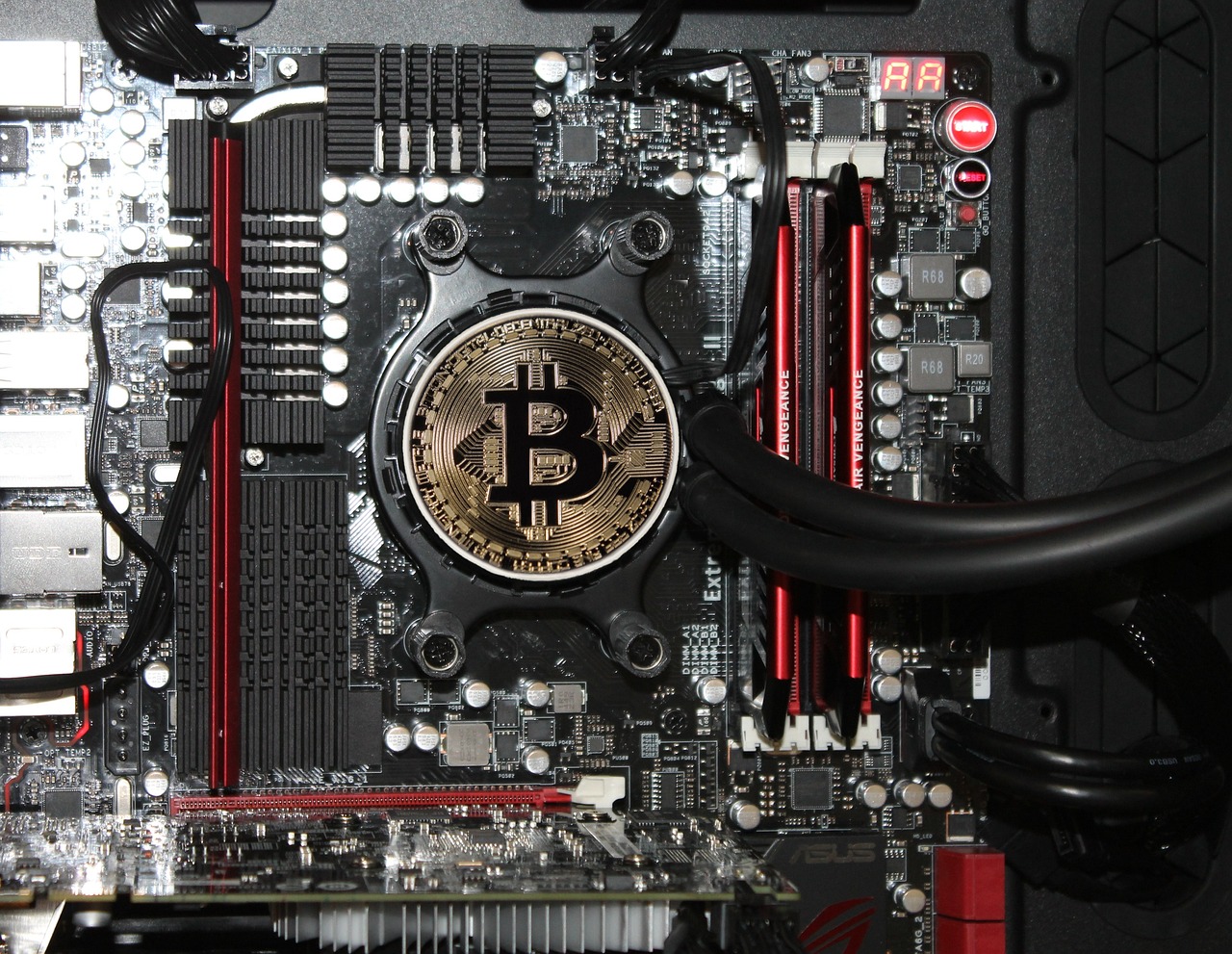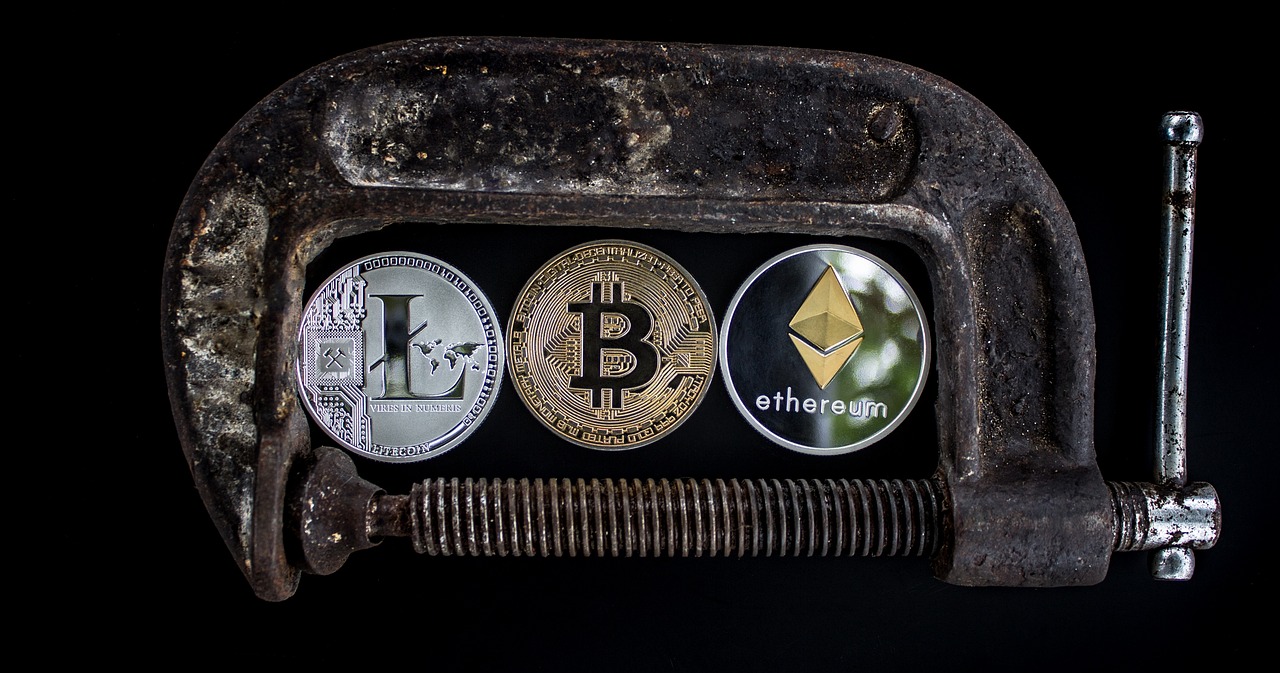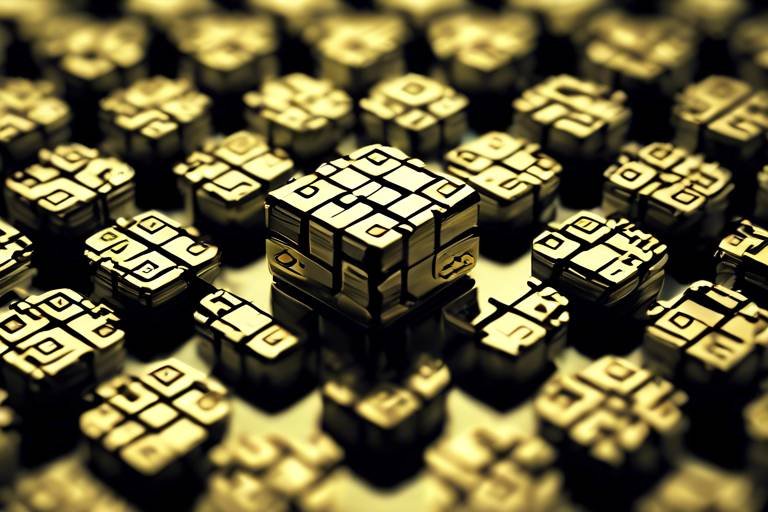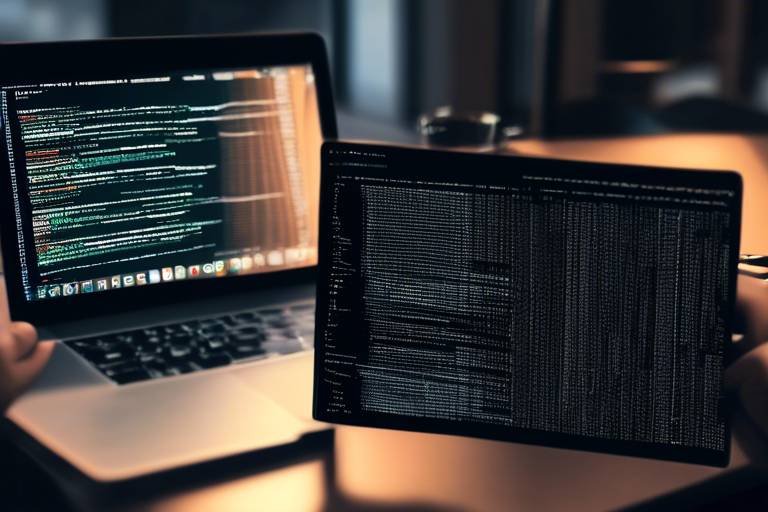The Role of Blockchain in Securing Intellectual Property
In today's fast-paced digital landscape, the protection of intellectual property (IP) has become more critical than ever. As creators, inventors, and businesses strive to innovate, the need for secure and reliable methods to safeguard their creations is paramount. Enter blockchain technology, a revolutionary approach that not only enhances IP protection but also streamlines processes and fosters innovation across various industries. Imagine a world where artists can sell their work without fear of forgery, or inventors can patent their ideas with absolute confidence. That’s the promise of blockchain, and it’s reshaping the way we think about ownership and rights.
At its core, blockchain operates as a decentralized digital ledger, providing a transparent and tamper-proof way of recording transactions. This means that every time an IP-related transaction occurs—be it a sale, license, or patent registration—it is securely documented in a manner that is visible to all authorized parties. This level of transparency not only builds trust among stakeholders but also significantly reduces the instances of fraud and disputes. Think of blockchain as a digital vault, where every piece of information is locked away securely, yet accessible to those who need it.
Moreover, the integration of smart contracts into the blockchain framework further enhances the efficiency of IP management. These self-executing contracts automatically enforce agreements, eliminating the need for intermediaries. This means that licensing agreements can be executed instantly, and royalty payments can be processed seamlessly, ensuring that creators are compensated fairly and promptly. It’s like having a digital assistant that never sleeps, always ensuring that the right parties get what they deserve without unnecessary delays.
However, while the benefits of blockchain in securing intellectual property are clear, it is essential to understand that this technology is not without its challenges. Issues like scalability and regulatory concerns can pose significant hurdles. As more users join the blockchain network, the speed and capacity of transactions can become bottlenecks. Additionally, the legal landscape surrounding blockchain is still evolving, which can create uncertainty for businesses looking to adopt this innovative solution.
Nevertheless, the potential of blockchain to revolutionize IP protection is undeniable. By addressing these challenges and harnessing the full capabilities of blockchain, we can pave the way for a more secure, efficient, and innovative future for intellectual property rights. The journey is just beginning, and as more industries embrace this technology, the possibilities are endless. With blockchain, we are not just securing intellectual property; we are building a foundation for creativity and innovation that respects and rewards the hard work of creators everywhere.
- What is blockchain technology? Blockchain is a decentralized digital ledger that records transactions across multiple computers securely and transparently.
- How does blockchain enhance IP protection? Blockchain ensures the immutability of records, provides transparency, and automates agreements through smart contracts, making IP transactions more secure and efficient.
- What are smart contracts? Smart contracts are self-executing contracts with the terms of the agreement directly written into code, which automatically enforce and execute when conditions are met.
- What challenges does blockchain face in IP protection? Scalability, regulatory concerns, and the need for widespread adoption are significant challenges that must be addressed for blockchain to be fully effective in IP management.

Understanding Intellectual Property
Intellectual property (IP) is a term that encompasses the creations of the mind, which can include a wide range of products and concepts. Think of it as the invisible currency of creativity and innovation. From inventions and literary works to designs and symbols, IP represents the unique ideas that fuel our economy and culture. Understanding its significance is crucial for both businesses and individuals, as it provides the necessary framework to protect these valuable creations effectively.
In today's fast-paced world, where ideas can be shared in the blink of an eye, the importance of safeguarding intellectual property cannot be overstated. Imagine you're an artist who has just created a stunning piece of artwork. Without proper protection, someone could easily replicate your work and profit from it without your consent. This is where intellectual property laws come into play, ensuring that creators retain control over their innovations and can reap the rewards of their hard work.
Intellectual property is generally categorized into several types, including:
- Patents: These protect inventions and grant the inventor exclusive rights to use, sell, or license their creations for a specific period.
- Copyrights: These safeguard original works of authorship, such as books, music, and films, allowing creators to control how their work is used and distributed.
- Trademarks: These protect symbols, names, and slogans used to identify goods or services, ensuring that consumers can distinguish between different brands.
- Trade Secrets: These refer to confidential business information that provides a competitive edge, such as formulas, practices, and processes.
Understanding these categories helps creators and businesses navigate the complex landscape of intellectual property rights. For instance, when launching a new product, a company must consider patenting its invention to prevent competitors from copying it. Similarly, artists should register their works for copyright protection to ensure they can claim ownership and control over their creations.
Moreover, the rise of digital technology has transformed how intellectual property is created, shared, and protected. With the internet making distribution easier than ever, the potential for infringement has increased significantly. This underscores the need for robust IP protection mechanisms that can adapt to the evolving landscape of creativity and innovation.
In conclusion, intellectual property is not just a legal concept; it's a vital part of our creative economy. By understanding its various forms and the importance of protecting them, individuals and businesses can foster an environment where innovation thrives. As we explore the role of blockchain in securing intellectual property rights, it becomes clear that these two elements can work together to create a more secure and efficient system for protecting creativity.

Blockchain Technology Explained
Blockchain technology is more than just a buzzword; it’s a revolutionary concept that has the potential to reshape industries. At its core, blockchain is a decentralized digital ledger that records transactions across many computers in such a way that the registered transactions cannot be altered retroactively. This ensures a high level of transparency and security, making it an ideal solution for safeguarding intellectual property rights.
Imagine a public library where every book has a unique identifier, and every time someone borrows a book, it’s logged in a system that everyone can see, but no one can change. This is essentially how blockchain operates. Each transaction is grouped into a block, and once a block is filled, it is added to a chain of previous blocks, creating a permanent record. This chain of blocks is distributed across a network, meaning no single entity has control over the entire chain, which drastically reduces the risk of fraud and unauthorized alterations.
One of the standout features of blockchain is its decentralization. Unlike traditional systems where a central authority governs the data, blockchain distributes the data across multiple nodes. This decentralization not only enhances security but also promotes trust among users. When everyone has access to the same data, it becomes incredibly difficult for any one party to manipulate the information. This is particularly beneficial for intellectual property, where the integrity of data is paramount.
Another key characteristic of blockchain is its immutability. Once data is entered into the blockchain, it cannot be changed or deleted. This feature is crucial for maintaining the integrity of intellectual property records. For example, if an artist registers their artwork on a blockchain, that record remains intact and can be verified by anyone at any time. This permanence ensures that creators can confidently assert their ownership and defend their rights against infringement.
Adding another layer of sophistication to blockchain are smart contracts. These are self-executing contracts with the terms of the agreement directly written into code. Smart contracts automate and enforce agreements without the need for intermediaries, making transactions more efficient. For instance, when a piece of music is streamed, a smart contract can automatically distribute royalties to the artist and other stakeholders based on predefined criteria. This not only speeds up the payment process but also increases transparency in royalty distribution.
In summary, blockchain technology offers a robust framework for securing intellectual property. Its decentralized nature, combined with immutable records and smart contracts, creates a secure environment for artists, inventors, and businesses alike. By leveraging these features, stakeholders can navigate the complexities of intellectual property management with greater confidence and efficiency.
- What is blockchain technology?
Blockchain technology is a decentralized digital ledger that securely records transactions across multiple computers, ensuring transparency and immutability.
- How does blockchain enhance intellectual property protection?
Blockchain enhances intellectual property protection by providing immutable records, reducing the risk of fraud, and enabling automated agreements through smart contracts.
- What are smart contracts?
Smart contracts are self-executing contracts with the terms directly written into code, allowing for automatic enforcement of agreements without intermediaries.
- Are there any challenges to implementing blockchain for IP protection?
Yes, challenges include scalability issues, regulatory concerns, and the need for widespread adoption across industries.

Decentralization and Security
Decentralization is one of the most revolutionary aspects of blockchain technology, fundamentally changing how we think about security in the digital age. Imagine a world where your data isn’t stored in one vulnerable location but is instead spread out across a vast network of computers. This is the essence of decentralization, and it brings with it a level of security that traditional systems simply can’t match.
When we talk about security in the context of intellectual property (IP), we must consider the risks associated with centralized systems. In a centralized model, all data is stored in a single database, making it an attractive target for hackers and unauthorized users. If that database is compromised, the consequences can be devastating. On the other hand, blockchain’s decentralized nature means that even if one part of the network is attacked, the integrity of the entire system remains intact. This makes it significantly harder for malicious entities to manipulate or steal valuable IP.
Moreover, the decentralized architecture of blockchain fosters trust among users. Each participant in the network has access to the same information, and any changes made to the data are reflected across the entire network almost instantaneously. This transparency not only enhances security but also builds confidence among creators and businesses that their intellectual property is safe from tampering. Imagine trying to convince an artist to share their work without the assurance that it won’t be stolen; blockchain offers that peace of mind.
In addition to decentralization, blockchain employs advanced cryptographic techniques to secure data. Each transaction is encrypted and linked to the previous one, creating a chain of blocks that is nearly impossible to alter. This immutability ensures that once an intellectual property right is recorded on the blockchain, it can’t be changed or erased without consensus from the network. This characteristic is crucial for maintaining the integrity of IP records, as it prevents disputes over ownership and rights.
To illustrate the security benefits of decentralization, consider the following table that compares centralized and decentralized systems:
| Feature | Centralized Systems | Decentralized Systems |
|---|---|---|
| Data Storage | Single location, vulnerable to attacks | Distributed across a network, reducing risk |
| Trust | Requires trust in a central authority | Trust is built through transparency |
| Data Integrity | Easily manipulated by unauthorized access | Immutable records ensure authenticity |
| Access Control | Single point of failure | Resilient against failures and attacks |
In conclusion, decentralization is not just a buzzword; it’s a game-changer for the security of intellectual property. By distributing data across a network and employing robust cryptographic techniques, blockchain technology provides a level of security that empowers creators and businesses alike. As we continue to explore the potential of blockchain in IP protection, it’s clear that the future holds exciting possibilities for enhanced security and trust.
- What is blockchain technology?
Blockchain is a decentralized digital ledger that records transactions across many computers, ensuring that the recorded data cannot be altered retroactively without the consensus of the network.
- How does decentralization enhance security?
Decentralization spreads data across a network, making it less vulnerable to attacks and reducing the risk of unauthorized access or manipulation.
- What are smart contracts?
Smart contracts are self-executing contracts with the terms of the agreement directly written into code, allowing for automated and secure transactions without the need for intermediaries.
- Can blockchain completely eliminate IP theft?
While blockchain significantly enhances security and traceability, it cannot completely eliminate IP theft. However, it makes it much more difficult to steal or manipulate intellectual property.

Immutable Records
When we talk about in the context of blockchain, we’re diving into one of the most fascinating aspects of this technology. Imagine a diary that, once written in, cannot be erased or altered. This is precisely how blockchain functions, ensuring that every piece of data recorded is permanent and secure. The immutability of blockchain records is not just a technical feature; it's a game-changer for intellectual property (IP) protection.
At its core, the idea of immutability means that once a record is added to the blockchain, it becomes part of a permanent chain of data. Each block in the blockchain is linked to the previous one, creating a robust framework that is incredibly difficult to tamper with. This characteristic is crucial for maintaining the integrity of intellectual property records, as it provides a reliable way to prove ownership and authenticity. For instance, if an artist registers their artwork on the blockchain, they can confidently assert that their claim to ownership is backed by an unalterable record. This is especially significant in a world where forgery and theft are rampant.
Furthermore, the immutability of records facilitates transparency in transactions. When a piece of intellectual property is bought or sold, the transaction is recorded on the blockchain, making it visible to all participants in the network. This transparency not only helps prevent disputes but also builds trust among creators, buyers, and investors. With every transaction traceable, it becomes much harder for anyone to claim ownership of an idea or product that isn’t theirs.
To illustrate the significance of immutable records, consider the following table that highlights the differences between traditional IP management systems and blockchain-based systems:
| Feature | Traditional IP Management | Blockchain-Based IP Management |
|---|---|---|
| Data Alteration | Records can be modified or deleted | Records are permanent and unchangeable |
| Transparency | Limited access to transaction history | Full visibility of all transactions |
| Dispute Resolution | Often lengthy and costly | Clear evidence of ownership minimizes disputes |
| Trust | Requires third-party verification | Trust is built through decentralized validation |
In conclusion, the concept of immutable records is not just about data security; it's about empowering creators and innovators. With blockchain, the fear of losing ownership or being accused of plagiarism diminishes significantly. As we continue to explore the potential of blockchain technology, it becomes increasingly clear that immutable records will play a vital role in the future of intellectual property management.
- What does immutability mean in blockchain? Immutability refers to the characteristic that once data is recorded on the blockchain, it cannot be altered or deleted.
- How does immutability protect intellectual property? It ensures that ownership records are permanent, making it difficult for anyone to claim rights over someone else's work.
- Can blockchain records be hacked? While no system is entirely hack-proof, the decentralized nature of blockchain makes it significantly harder to manipulate compared to traditional databases.
- What industries can benefit from immutable records? Industries such as art, music, patents, and pharmaceuticals can greatly benefit from the immutable nature of blockchain technology.

Smart Contracts
Smart contracts are one of the most revolutionary aspects of blockchain technology, acting like digital agreements that automatically execute when their conditions are met. Imagine a vending machine: you insert money and select your snack, and the machine delivers it without needing a cashier. Similarly, smart contracts eliminate the need for intermediaries in transactions, making processes smoother and more efficient. This is particularly beneficial in the realm of intellectual property (IP), where clarity and trust are paramount.
By utilizing smart contracts, creators can automate licensing agreements and royalty payments, ensuring that artists, inventors, and other IP holders receive their fair share without delays or disputes. For instance, when a song is streamed on a music platform, a smart contract can automatically calculate and distribute royalties to the artist, songwriter, and producer based on predefined terms. This not only enhances transparency but also significantly reduces the administrative burden associated with managing IP rights.
Furthermore, smart contracts can be programmed to include specific conditions that must be fulfilled before any action is taken. This feature is particularly useful in scenarios involving multiple stakeholders, such as collaborations between artists or joint ventures between companies. For example, if an artist collaborates with a brand to create a limited edition piece, a smart contract can stipulate that the artist receives a percentage of sales only after certain sales milestones are achieved. This ensures that all parties are incentivized to meet their obligations, fostering a cooperative environment.
However, while smart contracts offer numerous advantages, they are not without challenges. The coding of these contracts requires precision, as any errors can lead to unintended consequences. Additionally, the legal recognition of smart contracts varies across jurisdictions, which can complicate enforcement. Therefore, it’s crucial for users to engage with experienced developers and legal experts when creating these contracts to ensure they are robust and compliant with existing laws.
In summary, smart contracts are a game changer for the protection and management of intellectual property. They not only streamline processes but also enhance trust and security in transactions. As the technology continues to evolve, we can expect even more innovative applications that will further revolutionize how we think about and protect intellectual property.
- What is a smart contract? A smart contract is a self-executing contract with the terms of the agreement directly written into code, which automatically enforces and executes the terms when conditions are met.
- How do smart contracts enhance IP protection? They automate processes like licensing and royalty payments, ensuring timely and accurate transactions without the need for intermediaries.
- Are smart contracts legally binding? The legal status of smart contracts varies by jurisdiction, and it is essential to consult legal experts to ensure compliance with local laws.
- What are the risks associated with smart contracts? Risks include coding errors, potential security vulnerabilities, and varying legal recognition, which can complicate enforcement.

Benefits of Blockchain for IP Protection
When it comes to safeguarding intellectual property, blockchain technology emerges as a game-changer. One of the most significant benefits of using blockchain for IP protection is its ability to enhance traceability. Imagine a world where every creation, whether it’s a piece of art or a groundbreaking invention, can be tracked back to its original creator. With blockchain, each transaction is recorded in a decentralized ledger that is accessible to all, ensuring that the rightful owner can always be identified. This level of transparency can deter potential infringers who might think twice before stealing someone else's work.
Another remarkable advantage is the reduction of piracy. In industries plagued by copyright issues, such as music and film, blockchain can provide a robust solution. By using blockchain, creators can register their works and establish clear ownership records. This not only makes it easier to prove ownership in case of disputes but also facilitates a more straightforward process for taking legal action against infringers. The decentralized nature of blockchain means that no single entity controls the data, which significantly reduces the risk of manipulation and unauthorized access.
Moreover, blockchain technology enables improved enforcement of rights. With smart contracts, creators can automate the licensing process, ensuring that they receive fair compensation for their work without needing intermediaries. For instance, an artist can set up a smart contract that automatically pays them a royalty every time their song is streamed. This not only makes the process more efficient but also increases trust between creators and consumers. As a result, artists can focus more on their craft rather than worrying about whether they are getting paid fairly for their hard work.
In addition to these benefits, blockchain also fosters innovation by providing a secure platform for sharing and collaborating on new ideas. When inventors and creators can share their concepts without the fear of theft, it encourages a culture of innovation. They can collaborate more freely, knowing that their contributions are protected by the immutable nature of blockchain. This collaborative environment can lead to breakthroughs that might not have been possible in a more restrictive setting.
To summarize, the integration of blockchain technology into the realm of intellectual property protection brings forth numerous advantages:
- Enhanced Traceability: Every transaction is recorded, making it easy to trace ownership.
- Reduced Piracy: Clear ownership records deter potential infringers.
- Improved Enforcement: Smart contracts automate licensing and royalty payments.
- Fostering Innovation: A secure platform encourages collaboration and new ideas.
As we continue to navigate the complexities of intellectual property in a digital age, leveraging blockchain technology could very well be the key to a more secure and innovative future.
1. How does blockchain enhance the traceability of intellectual property?
Blockchain creates a decentralized ledger where every transaction is recorded, making it easy to trace the ownership of any intellectual property back to its original creator.
2. Can blockchain really reduce piracy?
Yes, by providing clear ownership records and making it easier to prove ownership, blockchain can deter potential infringers and streamline the process of taking legal action against them.
3. What are smart contracts, and how do they work in IP protection?
Smart contracts are self-executing contracts with the terms of the agreement directly written into code. They automate the licensing process and ensure that creators receive fair compensation without intermediaries.
4. How does blockchain foster innovation?
By providing a secure platform for sharing ideas and collaborations, blockchain encourages creators to work together without the fear of their concepts being stolen, leading to more innovative outcomes.

Case Studies of Blockchain in IP
When it comes to the real-world application of blockchain technology in protecting intellectual property (IP), there are some fascinating case studies that stand out. These examples not only highlight the potential of blockchain but also showcase how it can revolutionize various industries by providing secure and transparent solutions. One of the most notable sectors experiencing this transformation is the art world. Artists are often vulnerable to forgery and theft, which can undermine their creativity and financial stability. However, with blockchain, they can authenticate their works through unique digital signatures, ensuring that each piece has a verifiable history.
For instance, platforms like Artory have emerged, utilizing blockchain to create a secure registry for artworks. This allows artists to maintain a permanent record of ownership and provenance, drastically reducing the risk of counterfeit art flooding the market. Imagine being an artist who can prove the authenticity of your work with the click of a button! This level of transparency not only protects the artist but also builds trust with buyers, creating a more vibrant and secure marketplace for art.
Another compelling case can be found in the realm of patents and innovations. Traditional patent processes can be lengthy and fraught with disputes over ownership and originality. However, blockchain technology can streamline this process significantly. A prime example is the IBM Blockchain initiative, which aims to provide a secure platform for inventors to register their patents. By using blockchain, inventors can timestamp their ideas and securely store them, making it nearly impossible for anyone to claim ownership of their innovations without proof.
Furthermore, the use of smart contracts in the patenting process can automate licensing agreements, ensuring that inventors receive fair compensation for their inventions. This not only encourages innovation but also fosters a collaborative environment where ideas can flourish without the fear of theft. As we delve deeper into these case studies, it becomes clear that blockchain is not just a buzzword; it is a transformative technology that is reshaping the landscape of intellectual property.
In addition to art and patents, the music industry is also beginning to leverage blockchain. Platforms like Myco are utilizing blockchain to ensure that artists receive fair royalties for their work. By creating a transparent ledger of music rights and usage, artists can track how their music is being used and ensure they are compensated accordingly. This is particularly important in an industry where streaming services often take a significant cut of profits, leaving artists struggling to make a living.
As we can see from these examples, the implementation of blockchain in intellectual property protection is not just theoretical; it is happening now. These case studies illustrate the practical benefits of using blockchain technology to safeguard creativity, encourage innovation, and create a more equitable marketplace. The future of IP protection looks promising, and as more industries adopt this technology, we can expect to see even more innovative solutions emerge.
- What is blockchain technology?
Blockchain is a decentralized digital ledger that records transactions across many computers so that the recorded transactions cannot be altered retroactively.
- How does blockchain protect intellectual property?
It provides a secure and immutable record of ownership, which can help prevent forgery and unauthorized use of creative works.
- Are there any challenges to using blockchain for IP?
Yes, challenges include scalability, regulatory issues, and the need for widespread adoption across industries.

Art and Copyright
In today's fast-paced digital world, have become increasingly intertwined, and the advent of blockchain technology is revolutionizing how we think about ownership and authenticity in the art industry. Artists, collectors, and galleries are now facing challenges that were previously unheard of, such as forgery and unauthorized reproductions. Imagine an artist pouring their heart and soul into a masterpiece, only to have someone else claim it as their own. This is where blockchain steps in, offering a beacon of hope for safeguarding creative works.
One of the most significant advantages of blockchain in the art world is its ability to provide proof of ownership and provenance. Every piece of art can be linked to a unique digital token on the blockchain, which acts as a digital certificate of authenticity. This not only helps in verifying the legitimacy of the artwork but also traces its history, ensuring that artists receive recognition and compensation for their creations. In an industry where the value of a piece often hinges on its provenance, this technology can be a game-changer.
Furthermore, blockchain can facilitate direct transactions between artists and buyers, eliminating the need for intermediaries such as galleries or auction houses. This means that artists can retain a larger share of the profits from their work, empowering them financially. By using smart contracts, artists can also automate royalty payments, ensuring they receive ongoing compensation whenever their work is resold. This not only fosters a fairer system but also encourages artists to continue creating, knowing that their rights are protected.
However, while the potential of blockchain in art and copyright is immense, it's essential to address some challenges. For instance, the initial setup of blockchain technology can be complex and may require a shift in how artists and buyers approach transactions. Additionally, the environmental impact of certain blockchain networks raises concerns among environmentally conscious creators and collectors alike. As the technology evolves, it will be crucial to find solutions that mitigate these issues.
In summary, blockchain technology is paving the way for a more secure and transparent art market. With its ability to provide proof of ownership, streamline transactions, and automate royalty payments, it offers artists unprecedented control over their work. As we continue to explore the intersection of art and technology, the future looks promising for creators who seek to protect their intellectual property in an increasingly digital landscape.
- How does blockchain ensure the authenticity of artwork? Blockchain provides a permanent and tamper-proof record of ownership and provenance, making it easy to verify the authenticity of a piece.
- Can blockchain help artists receive royalties from resales? Yes, through smart contracts, artists can automate royalty payments, ensuring they receive compensation each time their work is resold.
- What are the challenges of using blockchain in the art industry? Challenges include the complexity of initial setup, potential environmental impacts, and the need for widespread adoption among artists and collectors.

Patents and Innovations
In today's fast-paced world, innovation is the lifeblood of progress. However, protecting those innovations is equally crucial, and that's where blockchain technology steps in as a game-changer. Imagine a world where inventors can securely register their groundbreaking ideas without the fear of theft or infringement. With blockchain, this vision is becoming a reality. By providing a transparent and secure platform for patent registration, blockchain not only protects intellectual property but also encourages a culture of innovation.
Blockchain's decentralized nature ensures that once an invention is recorded, it becomes part of an immutable ledger. This means that no one can alter or erase the record of ownership. Think of it as a digital vault that keeps your ideas safe from prying eyes and potential thieves. For inventors, this is a huge relief, as they can focus on what they do best—creating and innovating—without constantly looking over their shoulders.
Furthermore, the traditional patent process can often be bogged down by bureaucracy and red tape. Blockchain simplifies this process significantly. By utilizing smart contracts, inventors can automate various aspects of patent management, including:
- Submission of patent applications
- Tracking the status of applications
- Managing licensing agreements
This automation not only saves time but also reduces costs, making the patent process more accessible to startups and individual inventors. Instead of navigating through a labyrinth of paperwork and legal jargon, innovators can now engage with a straightforward, user-friendly system.
Moreover, the ability to create a digital proof of concept on the blockchain can significantly reduce disputes over patent ownership. With a timestamped record of when an idea was conceived, inventors have a reliable way to demonstrate their claim to a particular invention. This is particularly important in industries where the pace of innovation is rapid, such as technology and pharmaceuticals.
However, while blockchain offers immense potential for enhancing the patent landscape, it is not without its challenges. Issues such as scalability and the need for a robust regulatory framework must be addressed to fully realize its benefits. As blockchain networks expand, ensuring that they can handle a large volume of transactions efficiently is paramount. Additionally, as the legal landscape around blockchain continues to evolve, businesses must stay informed about the regulatory implications of adopting this technology.
In summary, blockchain technology is poised to revolutionize the way patents are managed and secured. By providing a transparent, immutable, and efficient system, it not only protects inventors but also fosters a thriving environment for innovation. As more industries begin to recognize the value of blockchain in intellectual property management, we can expect to see a surge in creativity and invention, paving the way for a brighter future.
- How does blockchain enhance patent security?
Blockchain provides an immutable record of patents, ensuring that once an invention is registered, it cannot be altered or deleted, thus protecting the inventor's rights. - Can blockchain simplify the patent application process?
Yes, by automating various aspects of the application process through smart contracts, blockchain can significantly reduce the time and cost associated with patent registration. - What challenges does blockchain face in the patent industry?
Scalability and regulatory compliance are significant challenges that need to be addressed to fully leverage blockchain's potential in managing patents.

Challenges and Limitations
While blockchain technology holds immense promise for securing intellectual property (IP), it is not without its . One of the most pressing issues is scalability. As the number of users and transactions on a blockchain network increases, the system can become congested, leading to slower transaction times and higher fees. This is particularly concerning for industries that require quick and efficient IP management. Imagine trying to sell a digital artwork during a peak period when the network is overloaded; the potential buyer may lose interest if the transaction takes too long!
Another significant hurdle is the regulatory framework. The legal landscape surrounding blockchain is still evolving, and many governments are grappling with how to regulate this technology effectively. This uncertainty can create a hesitance among businesses to adopt blockchain solutions for IP protection. For instance, if a company invests heavily in blockchain-based IP management but later finds itself navigating a complex web of regulations, the initial investment may not yield the expected returns. The lack of a consistent regulatory approach can lead to confusion and even legal challenges, making it crucial for businesses to stay informed about relevant laws and regulations.
Moreover, there is a need for widespread adoption. Blockchain technology, while revolutionary, requires a shift in how businesses and individuals perceive and manage IP. This shift can be daunting, especially for those accustomed to traditional methods. Convincing artists, inventors, and companies to embrace blockchain may require extensive education and demonstration of its benefits. If the majority of the industry is not on board, the effectiveness of blockchain in securing IP diminishes significantly. It's like trying to enjoy a new restaurant in a town where everyone insists on dining at the same old place; without collective enthusiasm, the new option struggles to thrive.
Furthermore, there are technical challenges that need addressing. Issues such as interoperability between different blockchain systems can complicate the implementation of IP protection measures. If various stakeholders are using different blockchains that do not communicate with one another, it can create barriers to seamless transactions and data sharing. This technical fragmentation could hinder the very efficiency that blockchain aims to provide.
In summary, while blockchain has the potential to revolutionize the way we protect and manage intellectual property, it is essential to acknowledge these challenges. By addressing scalability, regulatory concerns, the need for widespread adoption, and technical issues, stakeholders can work towards harnessing the full potential of blockchain technology in the realm of IP protection.
- What is blockchain technology? Blockchain is a decentralized digital ledger that records transactions across multiple computers in a way that ensures the security and transparency of data.
- How does blockchain enhance IP protection? It provides immutable records, automates agreements through smart contracts, and enhances traceability, making it harder for IP theft to occur.
- What are the main challenges facing blockchain in IP? Scalability issues, regulatory uncertainties, the need for widespread adoption, and technical challenges are some of the key obstacles.
- Can blockchain completely eliminate IP theft? While it significantly reduces the risks, no system can guarantee 100% protection against IP theft; however, blockchain enhances the ability to track and enforce rights.

Scalability Issues
Scalability is one of the most significant challenges facing blockchain technology today, particularly when it comes to its application in securing intellectual property. As the number of users and transactions increases, the strain on the blockchain network becomes apparent. Imagine a busy highway during rush hour; the more cars that join, the slower traffic moves. Similarly, as more transactions are added to a blockchain, the time it takes to process each transaction can increase dramatically.
One of the core issues is the limited capacity of many blockchain networks. For instance, Bitcoin can handle only about seven transactions per second, while Ethereum manages approximately 30. In contrast, traditional payment systems like Visa can process over 24,000 transactions per second! This disparity raises concerns about blockchain's viability for widespread use in industries where speed and efficiency are paramount.
To illustrate this issue further, consider the following table that compares transaction speeds of popular blockchain platforms against traditional systems:
| Platform | Transactions Per Second (TPS) |
|---|---|
| Bitcoin | 7 |
| Ethereum | 30 |
| Ripple | 1,500 |
| Visa | 24,000+ |
These numbers highlight the scalability issues that blockchain must overcome to be a viable solution for intellectual property management. If the technology cannot handle a high volume of transactions efficiently, it risks becoming obsolete in a fast-paced world where businesses need quick and reliable systems to protect their assets.
Moreover, the scalability problem is compounded by the energy consumption associated with many blockchain networks. The process of validating transactions requires significant computational power, leading to increased energy use and costs. This environmental concern not only affects the sustainability of blockchain technology but also raises ethical questions about its adoption.
Various solutions are being explored to tackle these scalability issues. Some of the most promising include:
- Layer 2 Solutions: These are secondary frameworks built on top of the existing blockchain to handle transactions off-chain, thereby reducing the load on the main network.
- Sharding: This technique divides the blockchain into smaller, more manageable pieces, or shards, allowing multiple transactions to be processed simultaneously.
- Consensus Mechanism Improvements: Transitioning from energy-intensive proof-of-work systems to more efficient mechanisms like proof-of-stake can significantly enhance transaction speeds.
In conclusion, while blockchain technology holds immense potential for securing intellectual property, scalability issues pose a significant barrier to its widespread adoption. As the technology evolves, addressing these challenges will be crucial for unlocking its full capabilities and ensuring that it can meet the demands of various industries looking to protect their innovations.
What is blockchain scalability?
Blockchain scalability refers to the ability of a blockchain network to handle an increasing number of transactions efficiently without compromising speed or performance.
Why is scalability important for intellectual property protection?
Scalability is crucial for intellectual property protection because it ensures that the system can handle a high volume of transactions, which is essential for businesses that rely on timely and efficient IP management.
What are some solutions to scalability issues in blockchain?
Solutions include layer 2 solutions, sharding, and improvements in consensus mechanisms, all aimed at enhancing transaction speed and efficiency.

Regulatory Framework
The intersection of blockchain technology and intellectual property (IP) is a fascinating yet complex landscape, particularly when it comes to the that governs it. As blockchain continues to gain traction across various industries, regulatory bodies are scrambling to keep pace with its rapid evolution. This creates a unique challenge for businesses and creators who wish to harness the power of blockchain for IP protection.
One of the primary concerns is that blockchain operates in a decentralized manner, which can sometimes clash with traditional regulatory approaches that rely on central authorities. For example, the lack of a singular governing body can make it difficult to enforce IP rights effectively. This decentralization leads to questions about who is responsible when violations occur, and how these violations can be addressed in a legal context.
Additionally, the legal status of smart contracts, which automate agreements and transactions, remains somewhat ambiguous in many jurisdictions. While some countries are making strides to recognize smart contracts as legally binding, others are still grappling with the implications of their use. This inconsistency can create a patchwork of regulations that complicate the adoption of blockchain solutions for IP management.
Moreover, regulatory frameworks must evolve to address the unique challenges posed by blockchain technology. For instance, the issue of data privacy is paramount. Since blockchain is inherently transparent, finding a balance between transparency and the protection of personal data is a pressing concern. Regulatory bodies must consider how to safeguard sensitive information while still allowing for the traceability that blockchain offers.
To navigate these challenges, businesses can adopt a proactive approach by staying informed about the evolving legal landscape. Engaging with legal experts who specialize in blockchain technology and IP law is essential. Companies should also consider participating in industry groups that advocate for clear and fair regulations. By doing so, they can contribute to shaping a regulatory environment that supports innovation while protecting intellectual property rights.
In summary, while the regulatory framework surrounding blockchain and intellectual property is still developing, it is crucial for businesses and creators to remain vigilant and adaptable. Understanding the legal implications of using blockchain technology can empower them to leverage its benefits while minimizing risks. As the landscape continues to evolve, those who are proactive in addressing these challenges will be better positioned to succeed in the digital age.
- What is the main challenge of blockchain in IP protection? The main challenge lies in the evolving regulatory framework that must adapt to the decentralized nature of blockchain.
- How do smart contracts fit into IP protection? Smart contracts automate agreements and transactions, but their legal status varies by jurisdiction.
- What role do regulatory bodies play in blockchain? Regulatory bodies are responsible for creating laws that govern blockchain technology and its applications, including IP protection.
- Can blockchain technology completely eliminate IP theft? While blockchain significantly enhances security and traceability, it cannot completely eliminate IP theft, especially in a rapidly changing digital environment.
Frequently Asked Questions
- What is intellectual property?
Intellectual property (IP) refers to creations of the mind, such as inventions, artistic works, and symbols. It's essential for individuals and businesses to understand IP to protect their innovations and ensure they receive recognition and financial benefits from their work.
- How does blockchain enhance IP protection?
Blockchain enhances IP protection through its decentralized nature, which ensures data security and transparency. By creating immutable records, blockchain prevents unauthorized alterations, making it easier to track ownership and enforce rights.
- What are smart contracts?
Smart contracts are self-executing contracts with the terms of the agreement directly written into code. They automate processes like licensing and royalty payments, eliminating the need for intermediaries and making transactions more efficient.
- Can blockchain help reduce piracy?
Yes! Blockchain can significantly reduce piracy by providing a transparent and traceable way to authenticate ownership. This makes it harder for counterfeiters to claim ownership of intellectual property, thus protecting creators' rights.
- What challenges does blockchain face in IP protection?
Blockchain faces several challenges, including scalability issues, regulatory concerns, and the need for widespread adoption. These factors can hinder its effectiveness in managing intellectual property rights, but ongoing advancements aim to address these limitations.
- How can artists benefit from blockchain technology?
Artists can benefit from blockchain by using it to authenticate their work, providing proof of ownership and provenance. This helps combat forgery and theft, ensuring that artists receive fair compensation for their creations.
- Is blockchain technology widely adopted for IP management?
While blockchain technology is gaining traction for IP management, it is not yet universally adopted. Many businesses are exploring its potential, but widespread implementation is still in progress as the technology and regulatory frameworks evolve.
- What is the future of blockchain in intellectual property?
The future of blockchain in intellectual property looks promising, with potential for more secure and efficient management of rights. As technology improves and regulatory frameworks develop, we can expect broader adoption and innovative applications in various industries.



















